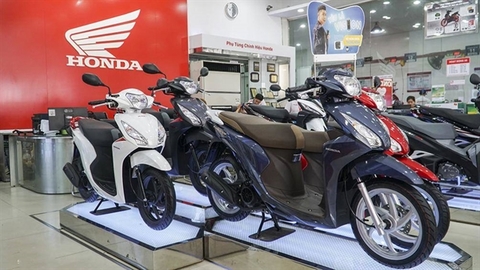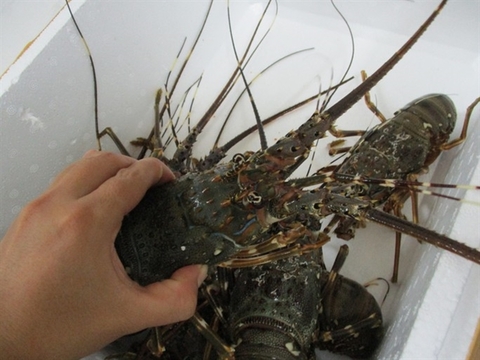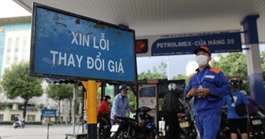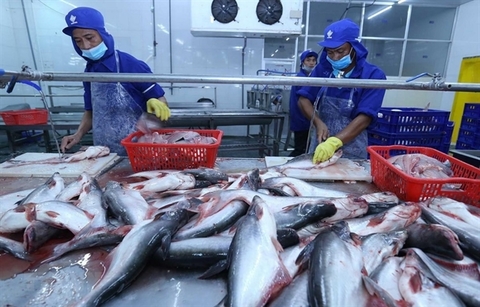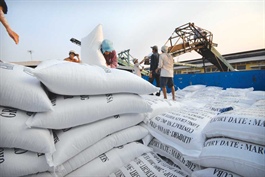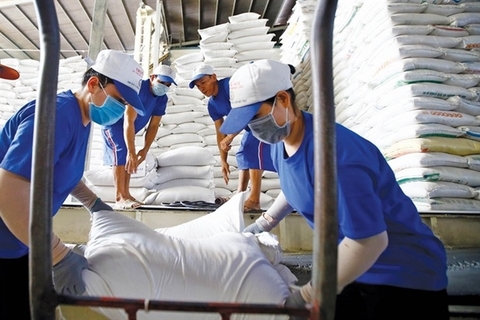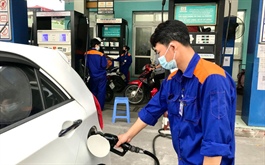Vietnamese rice exports need diverse markets
Vietnamese rice exports need diverse markets
The current ongoing Russia-Ukraine conflict and the efforts of major food exporters to limit the volume in their export quota has sent food prices to skyrocket controllably.
Illustrative photo. |
Now there are very visible global signs of an impending food crisis worldwide, which also is an opportune time to expand the Vietnam market and reduce dependency on China.
In the present gloomy economic scenario under rising inflation, the export figures in the statistical report released by the Ministry of Industry and Trade on the recent farming, forestry and fishery exports can be seen as a bright spot for the economy.
In the first five months of the year, exports from these fields reached USD 13.08 bln, a 20.3% year-on-year increase and making up 8.55% of the export turnover. All these fields were the key drivers of the country's export sector. Among them, the exports of aquatic products, rice, cassava, and cassava products earned USD 636 mln, an increase by 13.3% over the previous month, and 38.7% over last year. Export of rice alone earned USD 386 mln in May, rising by 39.9% over the previous month, and an increase of 14% over last year.
Ms. Nguyen Khanh Ngoc, Deputy Director of the European-American Market Department under the Ministry of Industry and Trade, said that the Russia-Ukraine conflict could be an opportunity for many Vietnamese agricultural products to further promote exports to the U.K. For instance, Ukraine supplies wheat to the U.K., and during the current conflict, the U.K. may switch to importing agricultural products from other suppliers, including Vietnam. This is an opportunity for Vietnamese rice to make its presence in the U.K. market. In addition to the U.K. market, the EU is also a strong potential market for Vietnamese rice.
Currently, the Philippines is still the biggest consumer of Vietnamese rice, accounting for 44.7% of the total volume and 42.6% of the total rice export turnover of Vietnam. The second biggest is the Chinese market, accounting for over 11.9% of the total volume and 12.4% of Vietnam's total rice export turnover. Ivory Coast ranks third among the importers of Vietnamese rice, accounting for 12.1% of the total volume and 10.6% of Vietnam's total rice export turnover.
Some food experts say that this export flow will make a shift and change in the next few years. Vietnamese rice is very likely to make its way into other markets such as the U.K., EU, and the United States, which previously had strict quality barriers that did not allow Vietnamese rice to gain a strong foothold here. This also means that some large markets that have long been major importers of Vietnamese rice are no longer playing a key role, such as China. This situation then minimizes market risks for Vietnamese rice exporting companies.
Restructuring essential
Mr Luong Phuoc Vinh, Southeast Asia Director of Tentamus Group, said that there is a great demand for food in Europe, and it is a golden chance for Vietnam to increase its exports to Europe, instead of depending too heavily on the Chinese market. This market's requirements are not too strict. It is important for businesses to understand the nature and requirements and reorganize production activities to satisfy the needs of this lucrative market. European partners say they are ready to support Vietnamese companies to export products to Europe when certain requirements are met, especially in the context of the current high food demand.
As a matter of fact, restructuring the Vietnamese food industry is not new, yet it has been making huge efforts for many years without any significant success. The plan to complete the restructuring of the Vietnamese rice industry by 2020 with a vision upto 2030 was implemented in 2016, with the overall goal of improving the efficiency of rice production and sale in a way that is able to lay a solid foundation for national food security; create jobs; increase income of rice farmers; protect the ecological environment; ensure sustainable development; and effectively participate in the global market.
At that time, several targets were set for the 2020 milestone, such as ensuring the profit for commodity rice growers to reach 30% or more of the total revenue. This could be achieved by using certified rice seeds of over 75% in the specialized farming areas of the Mekong Delta. In specialized farming areas, the area for joint production, consumption and construction of large fields should account for at least 20%. The area applying the sustainable farming process is required to reach at least 50% of the cultivatable area, with effort to reduce the amount of fertilizers and pesticides by 30% compared to the beginning. It also calls for reduction of post-harvest losses to less than 8%; and 20 % of the export rice must be labelled with Vietnamese rice brands.
However, until now after six years, many such important targets still lag far behind. While some requirements, such as ensuring food security, sufficient yields, and export turnovers have been met, targets such as increasing income of rice growers and building a brand name for Vietnamese rice still remains very hard to achieve.
One of the thorniest problems currently in the rice industry restructuring project is that the rice land use has been specifically planned for each region, but the plans have not been implemented satisfactorily. Several areas planned for growing rice have been harmed by the real estate fever.
In addition, production has not been sustainably organized, and the collaboration of rice production and consumption under the large-rice-field model has covered only about 500,000 hectares so far. The majority of raw rice consumption relies heavily on traders with lots of price fluctuations and high potential risks. Rice quality is also not uniform, which is seriously affecting the value and reputation of Vietnamese rice as an export product.
Asso. Prof. Dr. Bui Ba Bong, former Deputy Minister of Agriculture and Rural Development, said that up until now, Vietnam's food security has been basically ensured. The next goal in the coming years is to increase export value in terms of quality and sustainability and an effective brand. In order to effectively restructure the rice industry, it is imperative to synchronously implement a number of solutions such as improving the relevant institutions and policies, further taking advantage of advanced science and technology, and increasing infrastructure investments.
The instability of the world food market is against all expectations, but it is an opportunity for Vietnam to better understand the role of the food industry which is the driving force for restructuring for better sustainability.




